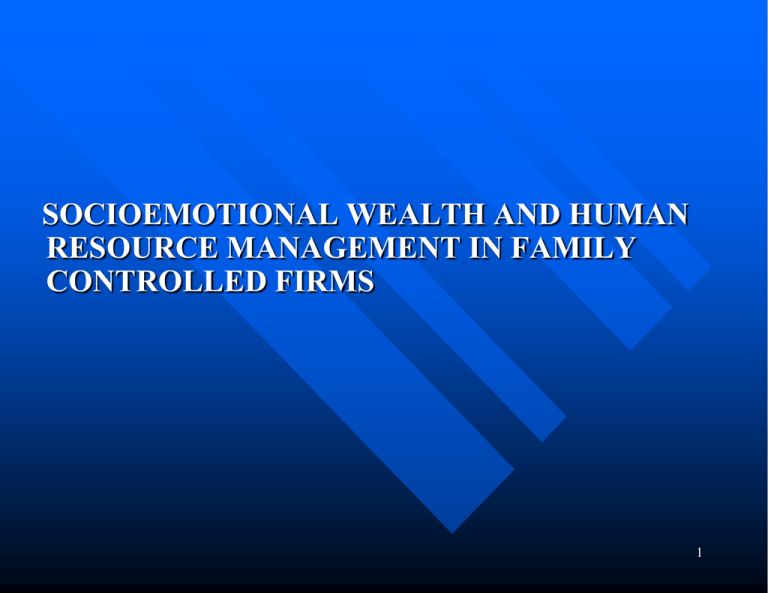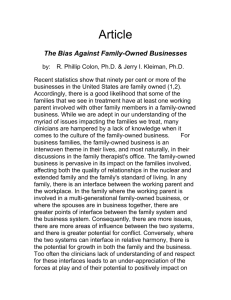because family-owned firms use sew as a frame of reference, they
advertisement

SOCIOEMOTIONAL WEALTH AND HUMAN RESOURCE MANAGEMENT IN FAMILY CONTROLLED FIRMS 1 WHY SHOULD WE CARE ABOUT FAMILY FIRMS • 95% of firms start out as family firms • At least 70% of firms in U.S.A. are controlled by families, including one third of Fortune 500 (e.g., Cargill, Motorola, Ford, Microsoft etc.) • At least 85% of firms in Southern European countries are controlled by families and 70% in northern countries • Around the world there is no doubt that families represent the predominant organizational form 2 STREAM OF RESEARCH SHOWING THAT FAMILY CONTROLLED FIRMS ARE UNIQUE IN THEIR MANAGEMENT PRACTICES • Gomez-Mejia, L. R. & Milkoveb, G. (Academy of Management Journal, 1976) Population: Day Care Consortium in Minneapolis, MN. • Gomez-Mejia, L., Nunez-Nickel, N., & Gutierrez, I. (Academy of Management Journal, 2001). Population: All Spanish newspaper starting in 1948. • Gomez-Mejia, L., Makri, M. & Larraza-Kintana, M (Academy of Management Journal, 2003). Population: All Fortune 1,000 Firms • Gomez-Mejia, L., Haynes, K., Nunez-Nickel, N., Moyana, J. (Administrative Science Quarterly, 2007). Population: Olive Oil Mills in Jaen(Spain), during 50 year period • Cruz, C., Gomez-Mejia, L. & Becerra, M. (Academy of Management Journal, 2010) Population: 122 Spanish firms 3 • Gomez-Mejia, L., Larraza-Kintana, M., and Makri, M. Population: Fortune 1000 firms (Journal of Management Studies, 2010 • Berrone, M., Cruz, C., Gomez-Mejia, L., Larraza-Kintana (Administrative Science Quarterly, 2010) Population: All firms reporting pollution levels to Environmental Protection Agency 4 KEY ARGUMENT FAMILY FIRMS ARE MOTIVATED BY MORE THAN THE MONETARY OUTCOME OF ORGANIZATIONAL ACTIVITY • The family’s desire to exercise authority • Enjoyment of family influence • Maintenance of clan membership within the firm • The appointment of trusted family member to important posts • Retention of a favorable family and firm reputation • The continuation of family dynasty SOCIOEMOTIONAL WEALTH is an umbrella term that accommodates all socioemotional elements of a family’s utility function that directly relate to the family’s involvement in the firm. As such, defined as “the stock of affect-related value that the family has invested in the firm.” 5 Figure 1. Family Firm Research from a Socioemotional Wealth Preservation Perspective Management Processes • Succession • Professionalization • Human Resource Contingency Variables • Family Stage • Firm Size • Firm Hazard • Presence of Non Family Shareholders Family Firm Socioemotional Wealth Preservation Strategic Choices • Risk Taking • Corporate Diversification • International Diversification • Acquisition Behavior • Debt • Accounting Choices Organizational Governance • Role of the Board • Incentive Alignment • Agency Contract Financial Performance Stakeholder Relationships • Stakeholder Management • Corporate Social Responsibility Business Venturing • Role of Families in New Ventures • Corporate Entrepreneurship 6 SOCIOEMTIONAL WEALTH AND HUMAN RESOURCE MANAGEMENT IN FAMILY FIRMS STAFFING PROPOSITION 1: BECAUSE FAMILY-OWNED FIRMS ARE MORE LIKELY TO USE SEW AS THE FRAME OF REFERENCE, THE RECRUITMENT PROCESS WILL TEND TO SHOW A GREATER RELIANCE ON P-O FIT THAN ON P-J FIT. • Emphasis on SEW preservation would imply that the firm will take the requisite steps to ensure that the people being hired will uphold the values and cultural ethos of the firm. • The company may often need to trade off employee capabilities and job specific knowledge in favor of person-organization compatibility because the believe such efforts will serve to protect the firm’s SEW and will be in the long term interest of the firm. • Firms with SEW as the frame of reference are likely to hold the view that lower levels of fit with the job can be addressed post selection through on-the-job training whereas poor compatibility with the organization’s core philosophy is difficult to remedy upon selection and could be really damaging for the SEW. 7 PROPOSITION 2: BECAUSE FAMILY-OWNED FIRMS ARE MORE LIKELY TO USE SEW AS A FRAME OF REFERENCE, THEY ARE LESS LIKELY TO RELY ON FORMAL RECRUITMENT METHODS. • Insights about a person’s ability to fit with the company’s culture cannot be readily obtained during the recruitment process owing to problems of adverse selection and provision of misleading information during the selection process. • Therefore, one would expect the family to use its social networks as a means to recruit people with better fit to the organization. 8 PROPOSITION 3: BECAUSE FAMILY-OWNED FIRMS ARE MORE LIKELY TO USE SEW AS A FRAME OF REFERENCE, THEY WILL HAVE A HIGHER PERCENTAGE OF HIRES WITH FAMILY TIES, EITHER BASED ON A BLOOD NEXUS OR STRONG SOCIAL TIES TO OWNING FAMILY. • Family owners are faced with the task of striking a balance between the benefits proffered by the non-family employee in terms of specialized knowledge and expertise and the potential erosion of SEW that may arise from the increased information asymmetries and goal conflict between outsiders and family members which results in greater behavioral uncertainty. 9 PROPOSITION 4: BECAUSE FAMILY-OWNED FIRMS USE SEW AS A FRAME OF REFERENCE, THEY ARE MORE LIKELY TO CHOOSE SUCCESSORS WHO ARE FAMILY MEMBERS. • A family successor would reinforce family power and influence in the company which is a key element of SEW. • Even in contexts where non-family successors are perceived as more suited to become leaders, they are unlikely to as closely identify with the family-owned firm and may harbor selfish interests. 10 PROPOSITION 5: BECAUSE FAMILY-OWNED FIRMS ARE LIKELY TO USE SEW AS A FRAME OF REFERENCE, THEY WILL HAVE A MORE CENTRALIZED SELECTION PROCESS WITH FAMILY MEMBERS PLAYING A KEY DECISION-MAKING ROLE. • Family-owned firms that strive to preserve their SEW are more likely to perpetuate owners’ direct or control and influence over any of the firm’s affairs irrespective of financial considerations (Gomez-Mejia et al., 2007). TRAINING & DEVELOPMENT PROPOSITION 6: BECAUSE FAMILY-OWNED FIRMS ARE MORE LIKELY TO USE SEW AS A FRAME OF REFERENCE, THEY WILL TEND TO INVEST MORE IN (LONG-TERM) CAREER DEVELOPMENT ACTIVITIES THAN IN TRAINING ACTIVITIES. • The company is seen as a long-term family investment to be bequeathed to descendents (Berrone et al., 2010). • The implementation of long-term focused developmental plans may help to instill new employees with the norms and values of the organization. 11 PROPOSITION 7: BECAUSE FAMILY-OWNED FIRMS ARE MORE LIKELY TO USE SEW AS A FRAME OF REFERENCE, THEY WILL TEND TO SHOW A GREATER PROCLIVITY TO MENTOR POTENTIAL SUCCESSORS. • If the junior successor fails to adjust to the demands and expectations of the new role, a premature exit may increase the risk that another family successor cannot be found, thereby eroding the firm’s SEW. • If the successor is adequately socialized to the role demands and expectations, owing to the mentoring received from the incumbent, family members or other stakeholders, his or her role commitment and identification increases, thus preserving the firm’s SEW and enhancing the likelihood of success in the succession process. 12 COMPENSATION & REWARD SYSTEMS PROPOSITION 8: BECAUSE FAMILY-OWNED FIRMS USE SEW AS A FRAME OF REFERENCE, THEY WILL TEND TO ADOPT A BELOW MARET PAY POLICY OR AT BEST “A MATCHING MARKET” PAY POLICY. PROPOSITION 9: BECAUSE FAMILY-OWNED FIRMS USE SEW AS A FRAME OF REFERENCE, THEY WILL TEND TO PLACE A GREATER EMPHASIS ON NON-MONETARY REWARDS. PROPOSITION 10: BECAUSE FAMILY-OWNED FIRMS USE SEW AS A FRAME OF REFERENCE, THEY WILL TEND TO PLACE A GREATER EMPHASIS ON INTERNAL EQUITY (VERSUS EXTERNAL MARKET EQUITY) IN THE DESIGN OF COMPENSATION CONTRACTS. • Job security in exchange for family loyalty replaces the need for strong incentives. • Family-owned firms are more likely to attract non-family employees who are less motivated by economic rewards, and more by other rewards, such as the promise of life-time job security and an informal work environment. 13 PROPOSITION 11: BECAUSE FAMILY-OWNED FIRMS USE SEW AS A FRAME OF REFERENCE, THEY WILL TEND TO PLACE A LOWER EMPHASIS ON VARIABLE (VERSUS FIXED) PAY. • The lower use of performance contingent and variable pay may be attributed to the fact that family owners have strong faith in the ability of family employees to work in the interest of the firm so it is not essential to make them accountable for every performance lapse as these may result from factors beyond their control. • It is also a signal of trustworthiness and of reciprocal obligations that do not need to be enforced throughout a formal contract. 14 PROPOSITION 12: BECAUSE FAMILY-OWNED FIRMS USE SEW AS A FRAME OF REFERENCE, THEY WILL TEND TO PLACE A LOWER EMPHASIS ON THE USE OF EQUITY BASED INCENTIVES. • Although family-owned firms that emphasize SEW have an interest in creating a common fate between the owners and non-family managers, granting equity to outsiders may also imply renouncing power and influence within the company. • It also “waters down” family ownership. When balancing both, familyowned firms may probably decide to protect their SEW by not giving equity based incentives to outsiders even then this may imply ignoring the benefits in terms of SEW gains of aligning interest between the nonfamily executive and the family owners. 15 PERFORMANCE APPRAISALS PROPOSITION 13: BECAUSE FAMILY-OWNED FIRMS USE SEW AS A FRAME OF REFERENCES, THEY ARE LESS LIKELY TO USE FORMAL APPRAISAL SYSTEMS. PROPOSITION 14: BECAUSE FAMILY-OWNED FIRMS USE SEW AS A FRAME OF REFERENCE, THEY WILL TEND TO PLACE A GREATER EMPHASIS ON THE USE OF QUALITATIVE MEASURES FOR EVALUATING EMPLOYEE PERFORMANCE. • Use of formal appraisal systems can bring the shortcomings of family or close employees to the fore • Family-owned firms that strive to preserve their SEW will refrain from using them because it may damage their SEW. • Inconsistencies in the use of formal appraisals for family and non-family employees can aggravate perceptions of injustice that exist within family-owned firms. • Hence, in family-owned firms that aim to preserve their SEW, the positive effects of implementing objective measures to assess employee performance will not outweigh the possible losses in SEW that may result from the implementation of such practices. 16 EMPLOYEE RELATIONS PROPOSITION 15: BECAUSE FAMILY-OWNED FIRMS USE SEW AS A FRAME OF REFERENCE, THEY WILL TEND TO PLACE A GREATER EMPHASIS ON INFORMAL COMMUNICATION CHANNELS. • Even in large family-owned firms, family owners and managers will place greater emphasis on informal interactions in order to strengthen the family ethos by personally conveying the culture and values of the family business. • Family owners may use informal interactions as a way to overcome non-family managers’ regular complaints about their lack of voice in the formal governance structures of the company, which are mainly controlled by the family. 17









